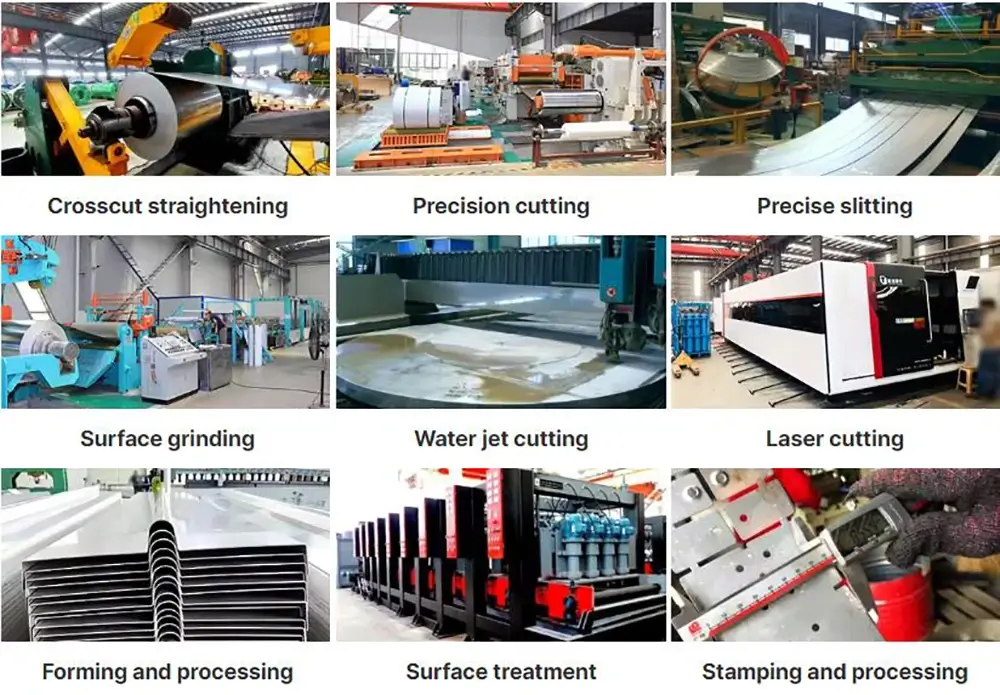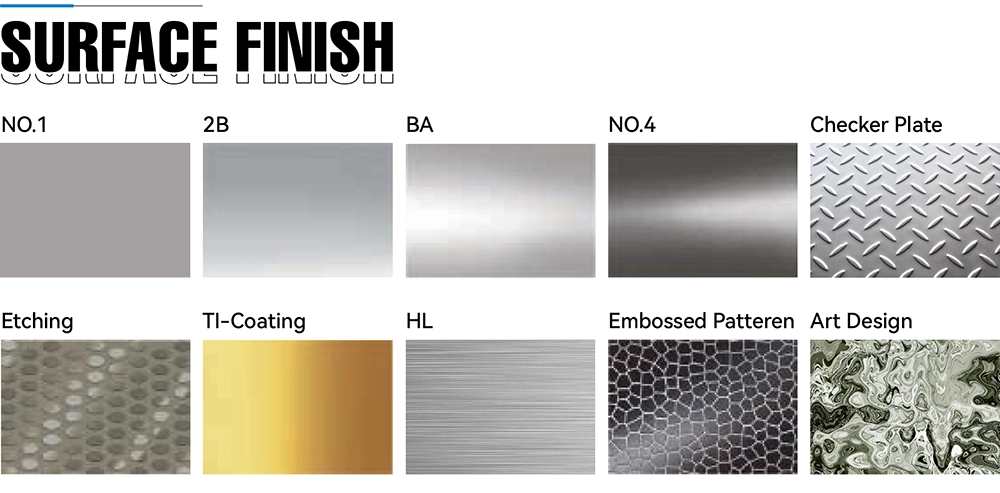316L is a lower carbon version of 316 with a maximum carbon content of 0.03%,known for superior corrosion resistance.
Cold rolled Thickness: 0.3-4 mm, custom size
Hot rolled Thickness: 3-120 mm, custom size
Width: 600mm, 1000mm, 1219mm, 1500mm, custom size
Length: 2000mm, 2438mm, 3000mm, custom size
316L stainless steel plate is stainless steel material with excellent performance and characteristics, is the low-carbon version of austenitic stainless steel 316, where L represents the low carbon content, the maximum carbon content of 0.03%, the main components of chromium (16-18%), nickel (10-14%), molybdenum (2-3%), and contains a small amount of manganese, silicon and other elements.
The low carbon content makes it less prone to carbide precipitation in welding or high temperature environments, to maintain corrosion resistance. Compared to 304 stainless steel, the addition of molybdenum in 316L dramatically increases its resistance to pitting and crevice corrosion in seawater and acidic conditions.
This low-carbon, molybdenum-enhanced alloy offers exceptional corrosion resistance, making it ideal for harsh environments like chemical plants, marine settings, and food processing facilities.These key Advantages making 316L stainless steel a popular choice:
Excellent Corrosion Resistance
316L stainless steel plate has excellent corrosion resistance, the high chromium and molybdenum content provides excellent resistance to general corrosion and seawater pitting, which reduces the need for maintenance and extends the life of the equipment, even in harsh environments.
Resistance to chloride corrosion
316L stainless steel has excellent corrosion resistance, the addition of molybdenum significantly improves resistance to chlorides (e.g. seawater, brine), acidic media (sulphuric acid, phosphoric acid, etc.) and industrial atmospheres, and is particularly good at resisting pitting and crevice corrosion.
Heat resistance
excellent oxidation resistance when used intermittently below 871°C (1600°F) or continuously below 927°C (1700°F); but need to avoid continuous use in the 427-857°C (800-1575°F) range. 316L stainless steel plate still maintains good corrosion resistance and strength under high-temperature conditions, suitable for high-temperature processes and equipment.
Weldability
316L stainless steel plate has good plasticity and malleability, easy to process and form, and can be used to manufacture complex shapes. The low carbon properties make it almost no precipitation of carbides in welding, thus ensuring corrosion resistance at the welded joints.
Mechanical properties
compared with some other stainless steel, 316L is non-magnetic in the annealed state (may be slightly magnetic after cold working), with tensile strength ≥ 70 ksi, yield strength ≥ 25 ksi, and elongation ≥ 40%
High strength
316L stainless steel plate has high yield strength and tensile strength, enabling it to provide reliable support in structural and assembly applications.
Standard: ASTM A240,EN10088
Technology: Hot rolled/Cold rolled
Cold rolled Thickness: 0.3-4 mm, custom size
Hot rolled Thickness: 3-120 mm, custom size
Width: 600mm, 1000mm, 1219mm, 1500mm, custom size
Length: 2000mm, 2438mm, 3000mm, custom size
Edge: Mill Edge, Slit Edge
Surface Finish: 2B, 2D, BA, 8K, NO.4, HL, NO.8, etc. Multiple finish options
Processing Service: Bending, Welding, Decoiling, Punching, Cutting, Shot Blasting, Heat Treatment ,etc
| Grade | C | Si | Mn | P | S | Ni | Cr | Mo |
| 316 | ≤0.08 | ≤1.0 | ≤2.0 | ≤0.045 | ≤0.03 | 10.0-14.0 | 16.0-18.0 | 2.0-3.0 |
| 316L | ≤0.03 | ≤1.0 | ≤2.0 | ≤0.045 | ≤0.03 | 11.0-14.0 | 16.0-18.0 | 2.0-3.0 |
| Mechanical Property of 316/316L | 316 | 316L |
| Yield Strength, min. (ksi) | 30 | 25 |
| Tensile Strength, min. (ksi) | 75 | 70 |
| Elongation, min. (%) | 40 | 40 |
| Hardness, max. (Rb) | 95 | 95 |
We offer precision shearing, laser/waterjet cutting, slitting, flattening and chamfering services to customize 316L plate to any size or shape. State-of-the-art equipment ensures that thickness and width tolerances meet stringent requirements

Plates are precision cold rolled and levelled for uniform thickness and high flatness. Provide a full range of finishes (hot-rolled, 2D matte, 2B mill finish, No.4 brushed, HL matte, BA bright anneal, 8K mirror, etc.) with optional annealing or polishing,to meet the different hygiene and aesthetics requirements.

We provide cut-to-length plates to ensure smooth edges. Each shipment is securely packaged ( in waterproof film bundles or wooden pallets) and labeled with a traceability number. The shipment is able to be accompanied by an EN 10204-3.1 Mill test certificates .
316L Stainless Steel Plate plays a critical role in various industries:
1. 316L vs 304 stainless steel:
316L has significantly better corrosion resistance than 304 in chloride environments (e.g. seawater) and high salt conditions due to its molybdenum content.
2. 316L vs 316 stainless steel:
The low carbon content (≤0.03%) of 316L makes it more suitable for welding and scenarios where annealing is not possible to avoid the risk of intergranular corrosion; while 316 has a higher carbon content (≤0.08%), slightly better strength but slightly weaker corrosion resistance.
Welding and processing:
Cold processing may cause slight magnetism, need to control the amount of cold deformation; welding should use low-carbon welding consumables to avoid intergranular corrosion
Temperature limitation:
Avoid long term use at 427-857°C to prevent degradation of material properties.
Complete control over products allows us to ensure our customers receive the best quality prices and service. Contact us for a free quote,JBLSTEEL will provide the right solution for your project.
개인정보 보호정책@ jblstainless. 허난 진바이라이 공업유한공사 판권 소유.